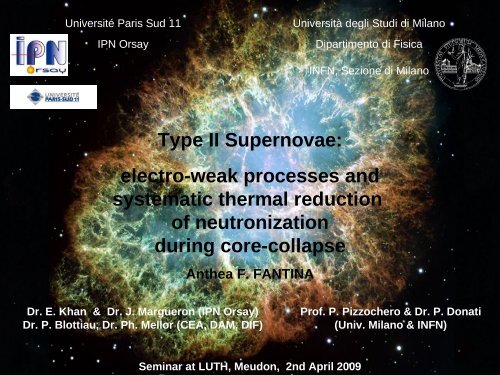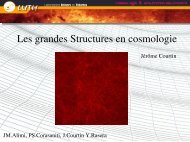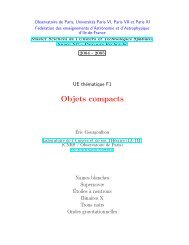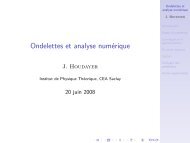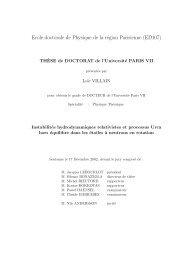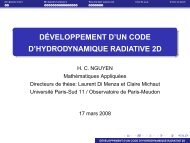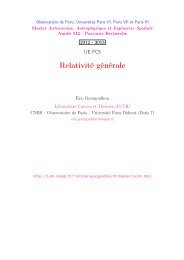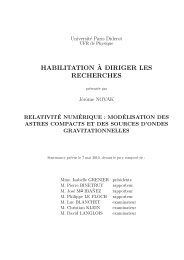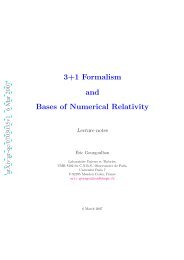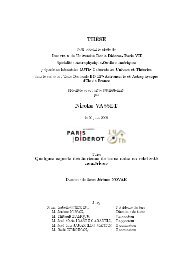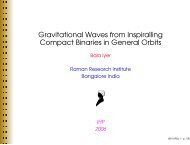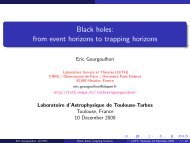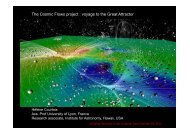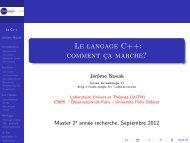Type II Supernovae: electro-weak processes and systematic ... - LUTH
Type II Supernovae: electro-weak processes and systematic ... - LUTH
Type II Supernovae: electro-weak processes and systematic ... - LUTH
You also want an ePaper? Increase the reach of your titles
YUMPU automatically turns print PDFs into web optimized ePapers that Google loves.
Université Paris Sud 11<br />
IPN Orsay<br />
<strong>Type</strong> <strong>II</strong> <strong>Supernovae</strong>:<br />
Università degli Studi di Milano<br />
Dipartimento di Fisica<br />
INFN, Sezione di Milano<br />
<strong>electro</strong>-<strong>weak</strong> <strong>processes</strong> <strong>and</strong><br />
<strong>systematic</strong> thermal reduction<br />
of neutronization<br />
during core-collapse<br />
Anthea F. FANTINA<br />
Dr. E. Khan & Dr. J. Margueron (IPN Orsay)<br />
Dr. P. Blottiau, Dr. Ph. Mellor (CEA, DAM, DIF)<br />
Seminar at <strong>LUTH</strong>, Meudon, 2nd April 2009<br />
Prof. P. Pizzochero & Dr. P. Donati<br />
(Univ. Milano & INFN)
Motivation<br />
Outline<br />
Introduction<br />
- <strong>Type</strong> <strong>II</strong> Supernova<br />
- Weak <strong>processes</strong> (Electron capture)<br />
Nucleon effective mass & symmetry energy<br />
Results<br />
- One zone code<br />
- 1D Newtonian code<br />
Conclusions & Outlook<br />
Anthea F. Fantina - Seminar @ <strong>LUTH</strong>, Meudon, 2nd April 2009
Motivation<br />
Outline<br />
Introduction<br />
- <strong>Type</strong> <strong>II</strong> Supernova<br />
- Weak <strong>processes</strong> (Electron capture)<br />
Nucleon effective mass & symmetry energy<br />
Results<br />
- One zone code<br />
- 1D Newtonian code<br />
Conclusions & Outlook<br />
Anthea F. Fantina - Seminar @ <strong>LUTH</strong>, Meudon, 2nd April 2009
Motivation<br />
• Simulations VS nature: what’s missing?<br />
• Nucleosynthesis of heavy elements<br />
• Neutrino physics<br />
• GW signal<br />
Microphysics Macrophysics<br />
Anthea F. Fantina - Seminar @ <strong>LUTH</strong>, Meudon, 2nd April 2009<br />
hydrodynamics<br />
nuclear physics
Motivation<br />
Outline<br />
Introduction<br />
- <strong>Type</strong> <strong>II</strong> Supernova<br />
- Weak <strong>processes</strong> (Electron capture)<br />
Nucleon effective mass & symmetry energy<br />
Results<br />
- One zone code<br />
- 1D Newtonian code<br />
Conclusions & Outlook<br />
Anthea F. Fantina - Seminar @ <strong>LUTH</strong>, Meudon, 2nd April 2009
<strong>Type</strong> <strong>II</strong> SN – Overview<br />
Anthea F. Fantina - Seminar @ <strong>LUTH</strong>, Meudon, 2nd April 2009<br />
1. Infall epoch:<br />
compression of the<br />
core to nuclear<br />
density<br />
(<strong>electro</strong>n capture)<br />
1. Core bounce<br />
<strong>and</strong> formation<br />
of shock wave<br />
1. Explosion:<br />
propagation of<br />
shock wave,<br />
possible explosion
Ch<strong>and</strong>rasekhar<br />
mass<br />
shock formation<br />
at the edge of<br />
homologous core<br />
( from Janka H.-Th. et al.,<br />
Phys. Rep. 442, 38 (2007) )<br />
SN<strong>II</strong> – picture of gravitational collapse<br />
Anthea F. Fantina - Seminar @ <strong>LUTH</strong>, Meudon, 2nd April 2009
Nuclear inputs:<br />
<strong>electro</strong>n capture rates<br />
Hydrodynamics:<br />
We investigate …<br />
… <strong>electro</strong>-<strong>weak</strong> <strong>processes</strong><br />
in core collapse supernova<br />
nucleon effective masses<br />
EoS<br />
→ one-zone code ( Fantina A.F. et al., arXiv:0811.0456 [astro-ph] )<br />
→ 1D Newtonian code ( Blottiau P., PhD thesis (1989) )<br />
→ 1D Relativistic code ( Romero J. et al., Astroph. J. 462, 839 (1996) )<br />
Anthea F. Fantina - Seminar @ <strong>LUTH</strong>, Meudon, 2nd April 2009
Electron capture (1/3)<br />
Anthea F. Fantina - Seminar @ <strong>LUTH</strong>, Meudon, 2nd April 2009<br />
μ p<br />
on free protons<br />
on nuclei<br />
Determine lepton fraction evolution position of formation of the shock<br />
before BBAL ( Bethe H.A. et al., Nucl. Phys. A324, 487 (1979) )<br />
<strong>electro</strong>n capture on free protons<br />
BBAL<br />
( Bethe H.A. et al., Nucl. Phys. A324, 487 (1979) )<br />
Low Xp capture on nuclei (A = 60 – 80 )<br />
Statistical model at T = 0<br />
Δ N ≈ 3 MeV<br />
μ n
Electron capture (2/3)<br />
Fuller ( Fuller G.M., Astrophys. J. 252, 741 (1982) )<br />
FFN ( Fuller G.M. et al., Astrophys. J. 293, 1 (1982)<br />
Fuller G.M. et al., Astrophys. J. Suppl. 48, 279 (1982))<br />
Capture on free protons dominates<br />
Two-level transition at T ≠ 0<br />
IPM; Pauli blocking effects for Z < 20, N ≥ 40<br />
x γ 2<br />
matrix element!<br />
Anthea F. Fantina - Seminar @ <strong>LUTH</strong>, Meudon, 2nd April 2009<br />
on free protons<br />
on nuclei<br />
In Bruenn parametrization ( good for multigroup calculation! )<br />
( Bruenn S.W., Astrophys. J. Suppl. 58, 771 (1985) )
Electron capture (3/3)<br />
Anthea F. Fantina - Seminar @ <strong>LUTH</strong>, Meudon, 2nd April 2009<br />
on free protons<br />
on nuclei<br />
Cooperstein & Wambach<br />
( Cooperstein J. <strong>and</strong> Wambach J., Nucl. Phys. A420, 591 (1984)<br />
Capture on nuclei with N ≥ 40 can compete with capture on free protons<br />
RPA calculations at finite T ( T ~ 1.5 MeV ) unblocking<br />
Langanke et al.<br />
( Langanke K. et al., Phys. Rev. C66, 45802 (2001) )<br />
Capture on nuclei dominates<br />
“Hybrid model” at T ≠ 0:<br />
- SMMC calculation (occupation number)<br />
- RPA calculation (capture rates)<br />
???<br />
… we run collapse for different capture rates (on nuclei)!
Motivation<br />
Outline<br />
Introduction<br />
- <strong>Type</strong> <strong>II</strong> Supernova<br />
- Weak <strong>processes</strong> (Electron capture)<br />
Nucleon effective mass & symmetry energy<br />
Results<br />
- One zone code<br />
- 1D Newtonian code<br />
Conclusions & Outlook<br />
Anthea F. Fantina - Seminar @ <strong>LUTH</strong>, Meudon, 2nd April 2009
Nucleon effective mass in nuclei (1/3)<br />
Interacting particle IPM (mean field)<br />
Σ(k) : mean field (ex. Skyrme)<br />
m*(k) < m<br />
Results: ok for single-particle energy,<br />
but not for level density!<br />
beyond IPM energy dependence of Σ<br />
Anthea F. Fantina - Seminar @ <strong>LUTH</strong>, Meudon, 2nd April 2009
Nucleon effective mass in nuclei (2/3)<br />
Beyond IPM particle-vibration coupling<br />
m* related to the group velocity<br />
m* related to level density (a from experiments!!!)<br />
k – mass<br />
Anthea F. Fantina - Seminar @ <strong>LUTH</strong>, Meudon, 2nd April 2009<br />
ω – mass T - dependence!
Physical interpretation<br />
Nucleon effective mass in nuclei (3/3)<br />
IPM: nucleon has a well defined energy<br />
spectral function S(k,ω) is a delta function<br />
beyond IPM: collisions taken into account<br />
spread in ω<br />
( Mahaux et al., Phys. Rep. 120, 1 (1985) )<br />
Ζ(k) : quasiparticle strenght<br />
probability amplitude<br />
that 1p (or 1h) excitation<br />
with momentum k<br />
propagates with energy ε(k)<br />
<strong>and</strong> lifetime τ<br />
Anthea F. Fantina - Seminar @ <strong>LUTH</strong>, Meudon, 2nd April 2009
sym<br />
T-dependence of m* <strong>and</strong> E<br />
Theoretical studies on influence<br />
of T-dependence of nuclear symmetry energy<br />
on collapse trajectory:<br />
Donati P. et al, Phys. Rev. Lett. 72, 2835 (1994)<br />
study of m*(T): 98 Mo, 64 Zn, 64 Ni in the range 0 < T < 2 MeV (QRPA)<br />
decrease of m*(T) in the range 0 < T < 2 MeV<br />
increase of E sym (~ 8%)<br />
effects on gravitational collapse not negligible<br />
Dean D.J. et al, Phys. Rev. C66, 31801 (2002)<br />
study of E sym (T): A = 56-66 in the range 0.33 < T < 1.23 MeV (SMMC)<br />
increase of E sym (~ 6%) consistent with Donati et al.<br />
“not significant changes for the collapse trajectory”<br />
Anthea F. Fantina - Seminar @ <strong>LUTH</strong>, Meudon, 2nd April 2009
lept,tr<br />
Effective mass Symmetry energy Y<br />
E symm (T)<br />
analogy with Fermi gas model<br />
Donati P. et al., Phys.Rev.Lett. 74 (1994)<br />
reduction of m ω with T ⇒ increase of E symm<br />
increase of<br />
less neutronization ⇒ larger values of Y lept at trapping<br />
Anthea F. Fantina - Seminar @ <strong>LUTH</strong>, Meudon, 2nd April 2009<br />
Q-value!
lept,tr<br />
Y<br />
Shock wave energy<br />
Shock wave loses energy while crossing matter.<br />
dissociation energy:<br />
larger values of Y lept at trapping ⇒ less deleptonization<br />
⇒ less energy dissipated<br />
Stronger shock wave explosion<br />
m*(T) E sym Y l,tr Shock wave energy<br />
Anthea F. Fantina - Seminar @ <strong>LUTH</strong>, Meudon, 2nd April 2009<br />
Brown G. et al,<br />
Nucl. Phys. A375, 481 (1982)
Motivation<br />
Outline<br />
Introduction<br />
- <strong>Type</strong> <strong>II</strong> Supernova<br />
- Weak <strong>processes</strong> (Electron capture)<br />
Nucleon effective mass & symmetry energy<br />
Results<br />
- One zone code<br />
- 1D Newtonian code<br />
Conclusions & Outlook<br />
Anthea F. Fantina - Seminar @ <strong>LUTH</strong>, Meudon, 2nd April 2009
Physical model – one-zone<br />
• One-zone code<br />
→ collapse of sphere with uniform density ρ<br />
• Matter made up by:<br />
- nuclei (A, Z), neutrons <strong>and</strong> free protons (C, NR)<br />
- <strong>electro</strong>ns <strong>and</strong> neutrinos (Q, UR)<br />
⇒ EoS BBP (Bethe et al., Nucl. Phys. A175, 225 (1971) )<br />
BBAL (Bethe et al., Nucl. Phys. A324, 487 (1979) )<br />
• Thermal dissociation in α particle included (Saha eq.)<br />
Entropy: translational (nuclei, protons <strong>and</strong> free neutrons),<br />
excited states of nuclei, <strong>electro</strong>ns <strong>and</strong> neutrinos (post trapping)<br />
• Electron capture on free+bound protons as 2-level transition at finite T<br />
( + backward reaction after trapping ), inclusion of γ 2<br />
• Trapping as a discontinuity ⇒ Yν = 0 if ρ < ρtr ( after neutrino trapping Ylept const! )<br />
Anthea F. Fantina - Seminar @ <strong>LUTH</strong>, Meudon, 2nd April 2009
Numerical results of collapse simulation<br />
(one-zone code)<br />
Anthea F. Fantina - Seminar @ <strong>LUTH</strong>, Meudon, 2nd April 2009<br />
γ 2 = 1<br />
Langanke K. et al.,<br />
Phys. Rev. Lett. 90, 241102 (2003)<br />
γ 2 = 0.1<br />
Fuller G.M.,<br />
Astroph. J. 252, 741 (1982)
Numerical results of collapse simulation<br />
(one-zone code)<br />
Anthea F. Fantina - Seminar @ <strong>LUTH</strong>, Meudon, 2nd April 2009<br />
“St<strong>and</strong>ard”<br />
parameters:
Physical model – 1D Newtonian<br />
• 1D code Newtonian ( Blottiau P., PhD thesis (1989) )<br />
- sphere divided in 40 zone for core, total 100 zone<br />
- Lagrangian treatment, implicit scheme<br />
• Matter made up by:<br />
- nuclei (A, Z), neutrons <strong>and</strong> free protons (classical e non relativistic)<br />
- <strong>electro</strong>ns <strong>and</strong> neutrinos (degenerate <strong>and</strong> ultra relativistic)<br />
⇒ EoS BBAL ( Bethe H.A. et al., Nucl. Phys. A324, 487 (1979) )<br />
Fuller ( Fuller G.M., Astrophys. J. 252, 741 (1982) )<br />
+ increasing of Γ to simulate stiffness of EoS<br />
• Hydro equation coupled to equation for <strong>electro</strong>n fraction evolution<br />
<strong>and</strong> capture<br />
• Neutrino transport: multigroup, inclusion of different N p * N h<br />
( Bruenn S., Astrophys. J. Suppl. 58, 771 (1985) )<br />
• Trapping comes out “automatically”<br />
Anthea F. Fantina - Seminar @ <strong>LUTH</strong>, Meudon, 2nd April 2009
Preliminary results of collapse simulation<br />
(1D Newtonian code)<br />
Anthea F. Fantina - Seminar @ <strong>LUTH</strong>, Meudon, 2nd April 2009
Motivation<br />
Outline<br />
Introduction<br />
- <strong>Type</strong> <strong>II</strong> Supernova<br />
- Weak <strong>processes</strong> (Electron capture)<br />
Nucleon effective mass & symmetry energy<br />
Results<br />
- One zone code<br />
- 1D Newtonian code<br />
Conclusions & Outlook<br />
Anthea F. Fantina - Seminar @ <strong>LUTH</strong>, Meudon, 2nd April 2009
Conclusions<br />
• Influence of T-dependence of E sym on the evolution of collapse<br />
→ <strong>systematic</strong> reduction of neutronization of the core<br />
(increasing of final lepton fraction) & less energy dissipated by shock wave<br />
- one zone model -<br />
→ position of shock wave formation: bigger homologous core<br />
- 1D Newtonian code -<br />
• Gain in shock wave dissociation energy if we consider m*(T) :<br />
δ T E diss ~ 0.4 foe (estimation with one-zone code,<br />
within reasonable physical ranges of parameters)<br />
<strong>and</strong>: K ~ 1 – 1.5 foe (Bethe H.A. & Pizzochero P., Astrophys. J. 350, L33 (1990))<br />
⇒ even if no dramatic effect on dynamics of the collapse is expected<br />
(see fluid instabilities, SASI, magnetic field, …)<br />
effects are not negligible!<br />
Anthea F. Fantina - Seminar @ <strong>LUTH</strong>, Meudon, 2nd April 2009
Outlook<br />
Nuclear point of view: Microscopic calculation of nuclear inputs<br />
- Electron capture rates on nuclei<br />
→ γ 2<br />
- Calculation of m*(T) & E sym (T):<br />
→ <strong>systematic</strong> calculations on more nuclei<br />
→ level density parameter (experiments?!)<br />
→ dependence on ρ, A, Z, T<br />
Astrophysical point of view: Hydrodynamics<br />
- multizone / multi-D code → test in 1D<br />
- Newtonian & Relativistic<br />
- more accurate treatment of neutrinos<br />
<strong>and</strong> shock formation<br />
IPN Orsay (E.Khan)<br />
- EoS<br />
→ Lattimer & Swesty, Nucl. Phys. A535, 331 (1991), with<br />
Anthea F. Fantina - Seminar @ <strong>LUTH</strong>, Meudon, 2nd April 2009<br />
Milan & IPN Orsay<br />
(P.Donati & J.Margueron)<br />
CEA Bruyères<br />
(P.Blottiau & Ph. Mellor)<br />
&<br />
<strong>LUTH</strong> Meudon<br />
(J. Novak & M.Oertel)
Thank you<br />
- Merci -<br />
Anthea F. Fantina - Seminar @ <strong>LUTH</strong>, Meudon, 2nd April 2009


